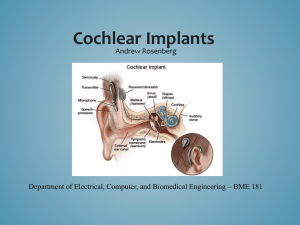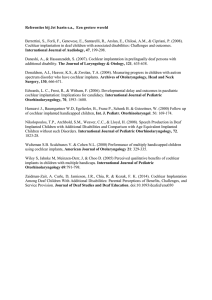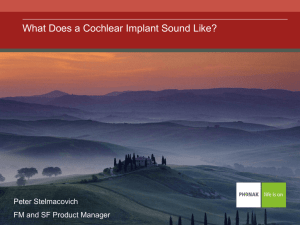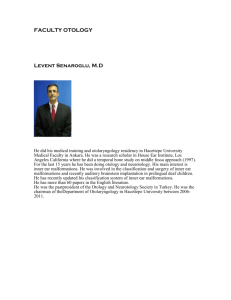Group Research Proposal Detailed Research Paper
advertisement
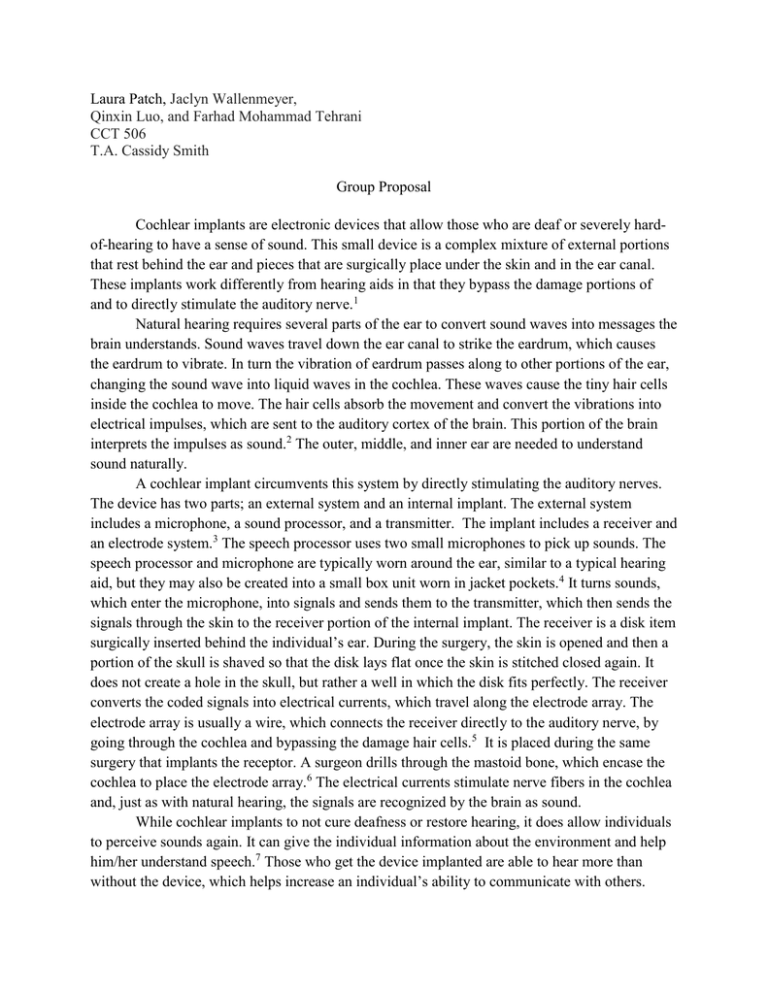
Laura Patch, Jaclyn Wallenmeyer, Qinxin Luo, and Farhad Mohammad Tehrani CCT 506 T.A. Cassidy Smith Group Proposal Cochlear implants are electronic devices that allow those who are deaf or severely hardof-hearing to have a sense of sound. This small device is a complex mixture of external portions that rest behind the ear and pieces that are surgically place under the skin and in the ear canal. These implants work differently from hearing aids in that they bypass the damage portions of and to directly stimulate the auditory nerve.1 Natural hearing requires several parts of the ear to convert sound waves into messages the brain understands. Sound waves travel down the ear canal to strike the eardrum, which causes the eardrum to vibrate. In turn the vibration of eardrum passes along to other portions of the ear, changing the sound wave into liquid waves in the cochlea. These waves cause the tiny hair cells inside the cochlea to move. The hair cells absorb the movement and convert the vibrations into electrical impulses, which are sent to the auditory cortex of the brain. This portion of the brain interprets the impulses as sound.2 The outer, middle, and inner ear are needed to understand sound naturally. A cochlear implant circumvents this system by directly stimulating the auditory nerves. The device has two parts; an external system and an internal implant. The external system includes a microphone, a sound processor, and a transmitter. The implant includes a receiver and an electrode system.3 The speech processor uses two small microphones to pick up sounds. The speech processor and microphone are typically worn around the ear, similar to a typical hearing aid, but they may also be created into a small box unit worn in jacket pockets.4 It turns sounds, which enter the microphone, into signals and sends them to the transmitter, which then sends the signals through the skin to the receiver portion of the internal implant. The receiver is a disk item surgically inserted behind the individual’s ear. During the surgery, the skin is opened and then a portion of the skull is shaved so that the disk lays flat once the skin is stitched closed again. It does not create a hole in the skull, but rather a well in which the disk fits perfectly. The receiver converts the coded signals into electrical currents, which travel along the electrode array. The electrode array is usually a wire, which connects the receiver directly to the auditory nerve, by going through the cochlea and bypassing the damage hair cells.5 It is placed during the same surgery that implants the receptor. A surgeon drills through the mastoid bone, which encase the cochlea to place the electrode array.6 The electrical currents stimulate nerve fibers in the cochlea and, just as with natural hearing, the signals are recognized by the brain as sound. While cochlear implants to not cure deafness or restore hearing, it does allow individuals to perceive sounds again. It can give the individual information about the environment and help him/her understand speech.7 Those who get the device implanted are able to hear more than without the device, which helps increase an individual’s ability to communicate with others. Most experts “agree that cochlear implants do not restore completely normal sensory information, but they do provide important cues for speech perception.”8 Cochlear implants, in many cases, make it easier to function in mainstream society since they are able to perceive more sound. For example, there may be more job opportunities that people may be capable of fulfilling if they have a higher level of hearing due to their implant. However, it is important to keep in mind that having a cochlear implant doesn’t necessarily guarantee that a person will be able to hear and speak at a relatively normal level, and the amount of perceptible sounds can change on a case-tocase basis. In some cases, the person with the implant can only hear some environmental sounds. The surgery is relatively un-risky. It is frequently performed on an outpatient basis; recipients of the implant do not have to even stay overnight. The total cost of the implant postoperative care, however, is very expensive. It can easily cost over $50,000. While some insurance plans may cover this cost, not all do. There are many individuals who cannot afford to get a cochlear implant even if they want one. Since cochlear implants digitize sound, part of the process is learning or relearning language. The difference between natural sounds and the way sounds are transmitted through a cochlear implant is so different that sounds have to be reassociated with their meanings. Adults can receive the implants and regain language understanding, but the older an adult is, the higher the inherent risk in the surgery. Children typically have an easier time than adults relearning how certain sounds associate to different people and situations, and thus cochlear implants are highly recommended for young children. Furthermore, deafness at a young age can have dramatic effects on a child’s development of language. 1.2 to 1.7 children in every 1,000 live births are born with hearing loss, and 20-30% of those have profound hearing loss.9 The number of children who are deaf “increases up to 6 years of age as a result of meningitis, the delayed onset of genetic hearing loss, or late diagnosis.” Studies have shown that children who are deaf by age 3 fall significantly behind their hearing peers with regards to master of language, whether in written, read, spoken, or signed forms, and this trend is regardless whether the child uses oral communication (excludes signs) or total communication (includes oral and manual sings).10 By the high school graduation, the median reading level of children who are deaf and have been since a young age is below the level of natural-hearing third graders.11 Cochlear implants will not fix this gap. Children who are deaf still learn language at slower rates than their natural-hearing peers because their was a delay in their learning. However, when compared to those children that do not receive the implant, children with cochlear implants acquire language skills at faster rates, and the mean rate of development is much closer to that of natural-hearing children.12 If a child who was born with profound hearing loss receives the implant before the age of two, she or he will enter first grade with receptive and expressive language skills that are close to their natural-hearing peers.13 One of the largest controversies about the cochlear implants is not with the expense of the surgery, although that certainly is a barrier, but with the tension between those who want the implant and the Deaf World. The Deaf World refers to a community comprised of members and advocates of a linguistic and cultural minority in the United States that uses sign language as their primary language. This group does not see themselves as handicapped, as many of the hearing community label them. Advocates of the Deaf World object to the use of pediatric cochlear implants on two levels. The first is that it does not increase the skills of perception by children enough to be worthwhile. As the technology only offers sensory information, the benefit to development of oral language is small. The second is it is unethical because parents make the choice for children, and this choice is essential a “genocide” of the Deaf World resulting in a dwindling number of children who would be part of the Deaf World.14 ASL and the Deaf World have creating a rich community within the mainstream world. When choosing to have their child receive an implant, parents must consider that they are choosing to deny their child full entry to the Deaf World. It can sometimes place a child in the awkward position of not really being part of either the natural-hearing community or the deaf one. 1 "Cochlear Implants." National Institute on Deafness and and Other Communication Disorders. National Institute of Health, Mar. 2011. Web. 18 Mar. 2013. 2 "The Ear: Auditory and Vestibular Systems." Partners in Assistive Technology Training and Services. N.p., July 2001. Web. 18 Mar. 2013. 3 "What Is a Cochlear Implant?" Medical Devices. FDA, 8 Sept. 2010. Web. 19 Mar. 2013. 4 "Cochlear Implants." ASHA.org. American Speech-Language-Hearing Association, 2013. Web. 19 Mar. 2013. 5 "Animation: Normal Ear, Ear with Hearing Loss, and Cochlear Implant Procedure."Medical Devices. FDA, 23 Sept. 2011. Web. 19 Mar. 2013. 6 "Inside a Cochlear Implant Surgery." Cochlear Implant Online. Cochlear Implant Online, 8 Apr. 2008. Web. 19 Mar. 2013. 7 "Cochlear Implants." ASHA.org. 8 Svirsky, Mario A., Amy M. Robbins, Karen Iler Kirk, David B. Pisoni, and Richard T. Miyamoto. "Language Development in Profoundly Deaf Children with Cochlear Implants." Psychological Science 11.2 (2000): 154. 9 Kral, Andrej, and Gerard M. O'Donoghue. "Profound Deafness in Childhood." New England Journal of Medicine 363.15 (2010): 1438. 10 Svirsky 153. 11 Svirsky 153. 12 Svirsky 155. 13 Kral 1438. 14 Svirsky 154.

